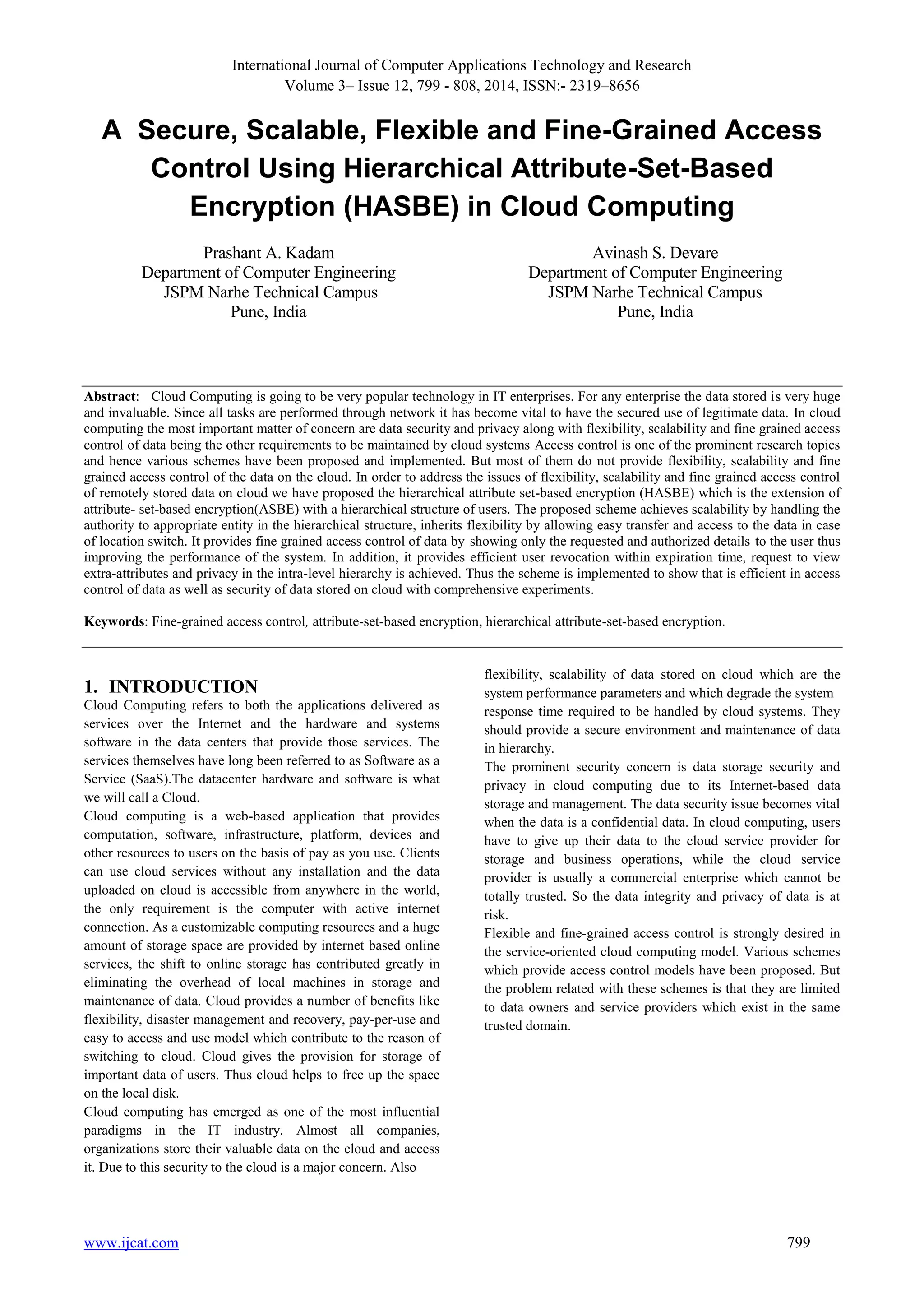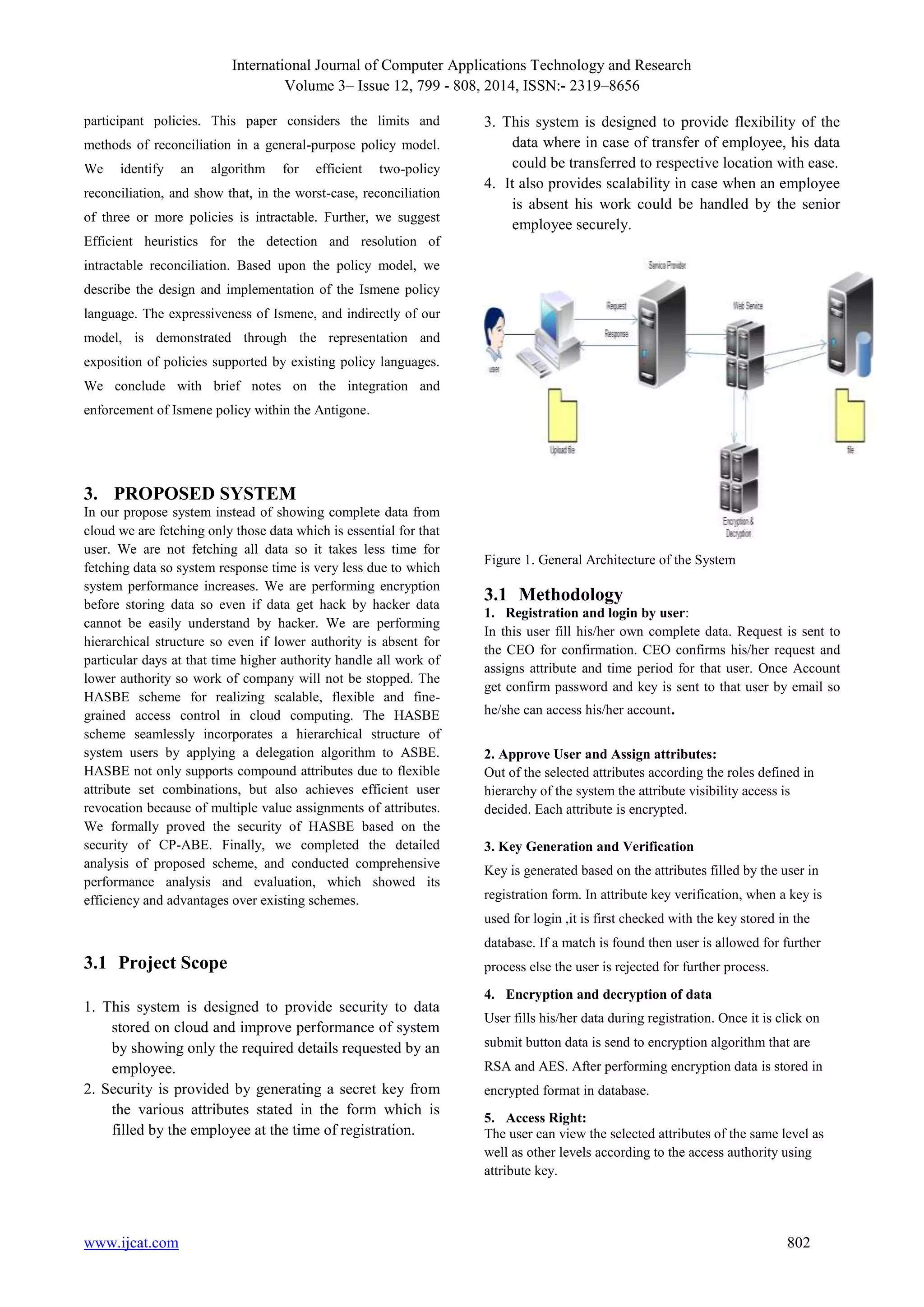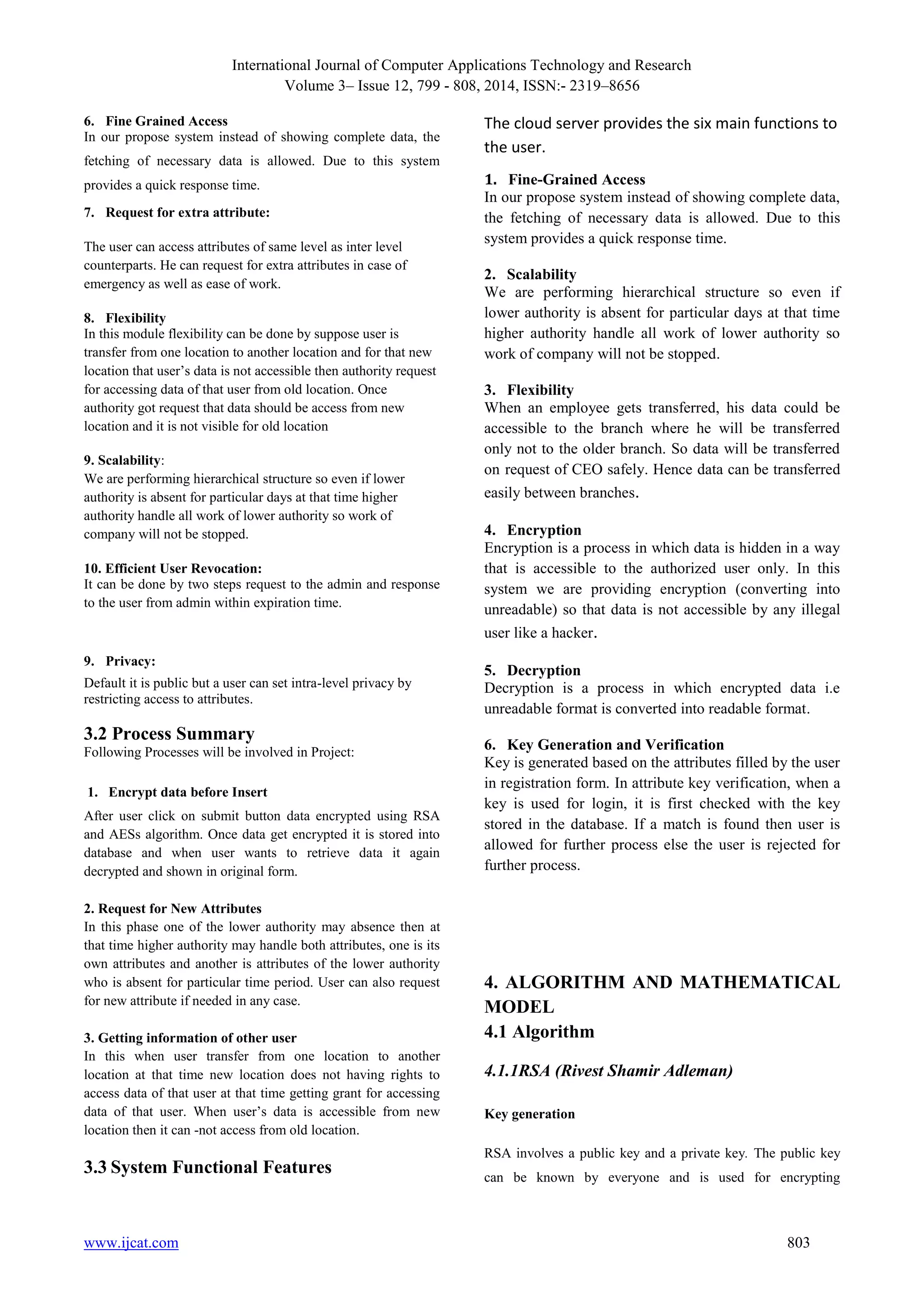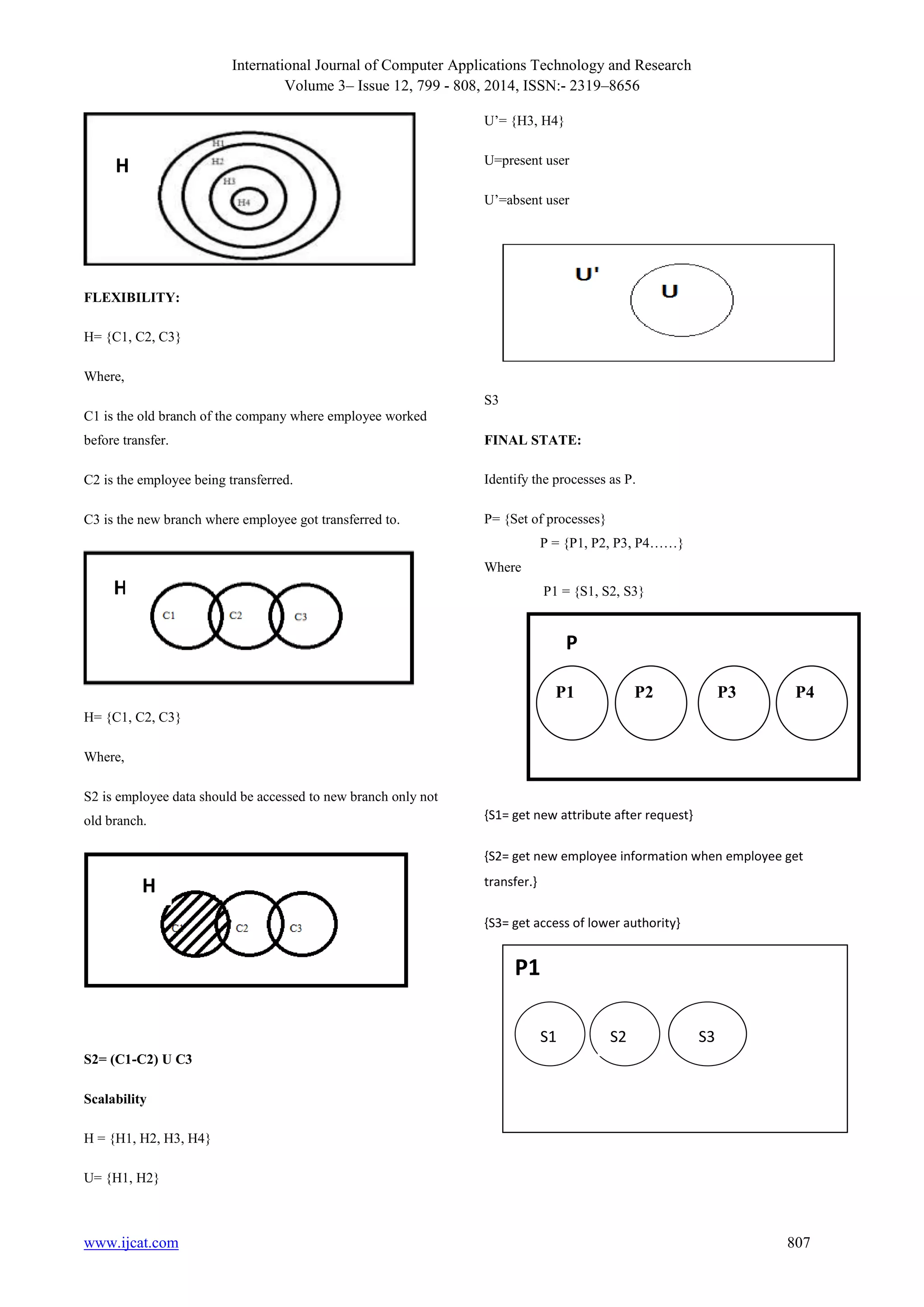The paper proposes a Hierarchical Attribute-Set-Based Encryption (HASBE) scheme to enhance data security, flexibility, scalability, and fine-grained access control in cloud computing. This approach improves user data access by utilizing a hierarchical structure that allows efficient data management and user revocation while ensuring that only authorized details are shown to users. Experimental results demonstrate the efficiency and advantages of the HASBE scheme over existing models in maintaining data security and performance within cloud environments.

![International Journal of Computer Applications Technology and Research
Volume 3– Issue 12, 799 - 808, 2014, ISSN:- 2319–8656
www.ijcat.com 800
2. EXISTING SYSTEM
2.1 Vipul et al.“ (Abe)Attribute based
encryption”. [1]
As more sensitive data is shared and stored by third-party sites
on the Internet, there will be a need to encrypt data stored at
these sites. One drawback of encrypting data, is that it can be
selectively shared only at a coarse-grained level (i.e., giving
another party your private key). We develop a new
cryptosystem for fine-grained sharing of encrypted data that we
call Key-Policy Attribute-Based Encryption (KP-ABE). In our
cryptosystem, cipher texts are labeled with sets of attributes
and private keys are associated with access structures that
control which cipher texts a user is able to decrypt. We
demonstrate the applicability of our construction to sharing of
audit-log information and broadcast encryption. Our
construction supports delegation of private keys which
subsumes Hierarchical Identity-Based Encryption (HIBE).
2.2 Rakesh et al. “Attribute-Sets: A
Practically Motivated Enhancement to
Attribute-Based Encryption”, University of
Illinois at Urbana-Champaign, July 27,
2009. [2]
In distributed systems users need to share sensitive objects with
others base on the recipients‟ ability to satisfy a policy.
Attribute-Based Encryption (ABE) is a new paradigm where
such policies are specified and cryptographically enforced in
the encryption algorithm itself. Cipher text-Policy ABE (CP-
ABE) is a form of ABE where policies are associated with
encrypted data and attributes are associated with keys. In this
work we focus on improving the flexibility of representing user
attributes in keys. Specifically, we propose Cipher text Policy
Attribute Set Based Encryption (CP-ASBE) - a new form of
CP-ABE - which, unlike existing CP-ABE schemes that
represent user attributes as a monolithic set in keys, organizes
user attributes into a recursive set based structure and allows
users to impose dynamic constraints on how those attributes
may be combined to satisfy a policy. We show that the
proposed scheme is more versatile and supports many practical
scenarios more naturally and efficiently. We provide a
prototype implementation of our scheme and evaluate its
performance overhead
2.3 Pankaj et al. “Cloud Computing Security
Issues in Infrastructure as a Service”, 2012.
[3]
Cloud computing is current buzzword in the market. It is
paradigm in which the resources can be leveraged on peruse
basis thus reducing the cost and complexity of service
providers. Cloud computing promises to cut operational and
capital costs and more importantly it let IT departments focus
on strategic projects instead of keeping datacenters running. It
is much more than simple internet. It is a construct that allows
user to access applications that actually reside at location other
than user‟s own computer or other Internet-connected devices.
There are numerous benefits of this construct. For instance
other company hosts user application. This implies that they
handle cost of servers, they manage software updates and
depending on the contract user pays less i.e. for the service
only. Confidentiality, Integrity, Availability, Authenticity, and
Privacy are essential concerns for both Cloud providers and
consumers as well. Infrastructure as a Service (IaaS) serves as
the foundation layer for the other delivery models, and a lack
of security in this layer will certainly affect the other delivery
models, i.e., PaaS, and SaaS that are built upon IaaS layer. This
paper presents an elaborated study of IaaS components‟
security and determines vulnerabilities and countermeasures.
Service Level Agreement should be considered very much
importance.
2.4 John et al. “(CP-ABE) Cipher text-Policy
Attribute-Based Encryption” John et al. [4]
In several distributed systems a user should only be able to
access data if a user posses a certain set of cre- dentials or
attributes. Currently, the only method for enforcing such
policies is to employ a trusted server to store the data and
mediate access control. However, if any server storing the data
is compromised, then the confidentiality of the data will be
compromised. In this paper we present a system for realizing
complex access control on encrypted data that we call Cipher
text-Policy Attribute-Based Encryption. By using our
techniques encrypted data can be kept confidential even if the
storage server is not trusted; moreover, our methods are secure
against collusion attacks. Previous Attribute- Based Encryption
systems used attributes to describe the encrypted data and built](https://image.slidesharecdn.com/ijcatr03121010-150111091651-conversion-gate01/75/A-Secure-Scalable-Flexible-and-Fine-Grained-Access-Control-Using-Hierarchical-Attribute-Set-Based-Encryption-HASBE-in-Cloud-Computing-2-2048.jpg)
![International Journal of Computer Applications Technology and Research
Volume 3– Issue 12, 799 - 808, 2014, ISSN:- 2319–8656
www.ijcat.com 801
policies into user‟s keys; while in our system attributes are
used to describe a user‟s credentials, and a party encrypting
data deter-mines a policy for who can decrypt. Thus, our meth-
ods are conceptually closer to traditional access control
methods such as Role-Based Access Control (RBAC). In
addition, we provide an implementation of our sys- tem and
give performance measurements.
2.5 Ayad et al. “Enabling Data Dynamic and
Indirect Mutual Trust for Cloud Computing
Storage System”, 2012. [6]
In this paper, we propose a cloud-based storage scheme that
allows the data owner to benefit from the facilities offered by
the CSP and enables indirect mutual trust between them. The
proposed scheme has four important features: (i) it allows the
owner to outsource sensitive data to a CSP, and perform full
block-level dynamic operations on the outsourced data, i.e.,
block modification, insertion, deletion, and append, (ii) it
ensures that authorized users (i.e., those who have the right to
access the owner‟s file) receive the latest version of the
outsourced data, (iii) it enables indirect mutual trust between
the owner and the CSP, and (iv) it allows the owner to grant or
revoke access to the outsourced data. We discuss the security
issues of the proposed scheme. Besides, we justify its
performance through theoretical analysis and experimental
evaluation of storage, communication, and computation
overheads.
2.6 Guojun et al. “Hierarchical attribute-
based encryption and scalable user
revocation for sharing data in cloud
servers”, 2011. [8]
With rapid development of cloud computing, more and more
enterprises will outsource their sensitive data for sharing in a
cloud. To keep the shared data confidential against untrusted
cloud service providers (CSPs), a natural way is to store only
the encrypted data in a cloud. The key problems of this
approach include establishing access control for the encrypted
data, and revoking the access rights from users when they are
no longer authorized to access the encrypted data. This paper
aims to solve both problems. First, we propose a hierarchical
attribute-based encryption scheme (HABE) by combining a
hierarchical identity-based encryption (HIBE) system and a
ciphertext-policy attribute-based encryption (CP-ABE) system,
so as to provide not only fine-grained access control, but also
full delegation and high performance. Then, we propose a
scalable revocation scheme by applying proxy re-encryption
(PRE) and lazy re-encryption (LRE) to the HABE scheme, so
as to efficiently revoke access rights from users.
2.7 Qin et al. “Hierarchical Attribute-Based
Encryption for Fine-Grained Access Control
in Cloud Storage Services”. [9]
Cloud computing, as an emerging computing paradigm,
enables users to remotely store their data into a cloud so as to
enjoy scalable services on-demand. Especially for small and
medium-sized enterprises with limited budgets, they can
achieve cost savings and productivity enhancements by using
cloud-based services to manage projects, to make
collaborations, and the like. However, allowing cloud service
providers (CSPs), which are not in the same trusted domains as
enterprise users, to take care of confidential data, may raise
potential security and privacy issues. To keep the sensitive user
data confidential against untrusted CSPs, a natural way is to
apply cryptographic approaches, by disclosing decryption keys
only to authorized users. However, when enterprise users
outsource confidential data for sharing on cloud servers, the
adopted encryption system should not only support fine-
grained access control, but also provide high performance, full
delegation, and scalability, so as to best serve the needs of
accessing data anytime and anywhere, delegating within
enterprises, and achieving a dynamic set of users. In this paper,
we propose a scheme to help enterprises to efficiently share
confidential data on cloud servers. We achieve this goal by first
combining the hierarchical identity-based encryption (HIBE)
system and the cipher text-policy attribute-based encryption
(CP-ABE) system, and then making a performance-
expressivity tradeoff, finally applying proxy re-encryption and
lazy re-encryption to our scheme.
2.8. Patrick et al. “Methods and Limitations
of Security Policy Reconciliation”. [10]
A security policy is a means by which participant session
requirements are specified. However, existing frameworks
provide limited facilities for the automated reconciliation of](https://image.slidesharecdn.com/ijcatr03121010-150111091651-conversion-gate01/75/A-Secure-Scalable-Flexible-and-Fine-Grained-Access-Control-Using-Hierarchical-Attribute-Set-Based-Encryption-HASBE-in-Cloud-Computing-3-2048.jpg)


![International Journal of Computer Applications Technology and Research
Volume 3– Issue 12, 799 - 808, 2014, ISSN:- 2319–8656
www.ijcat.com 804
messages. Messages encrypted with the public key can only be
decrypted in a reasonable amount of time using the private key.
Encryption
User1 transmits her public key (n, e) to User2 and keeps the
private key secret. User1 then wishes to send message M to
User2.He first turns M into an integer m, such that 0 ≤ m < n
by using an agreed-upon reversible protocol known as a
scheme. He then computes the cipher text c corresponding to
This can be done quickly using the method of exponentiation
by squaring. User1 then transmits c to User2.Note that at least
nine values of m will yield a cipher text c equal to m, but this is
very unlikely to occur in practice.
Decryption
User can recover m from c by using her private key exponent.
Given m, user can recover the original message M by reversing
the padding scheme.
4.1.2 Advanced Encryption Standard Algorithm
The AES algorithm is also used for improving the searching
and access mechanism.
4.2 Mathematical Model
We are using NP-Complete because it gives output within fix
interval of time.
Set Theory Analysis
A] Identify the Employees
E= {e1, e2, e3….}
Where „E‟ is main set of Employees like e1, e2, e3…
B] Identify the Attribute
AT= {at1, at2, at3….}
Where „AT‟ is main set of registered Attribute like at1, at2,
at3…
C] Identify the employee requested For another Attribute
RAA= {raa1, raa2, raa3}
Where „RAA‟ is main set of Request for another Attribute
raa1, raa2, raa3
D] Identify the employee requested for another employee
Information
REI= {rei1, rei2, rei3}
Where „REI‟ is main set of Request for another Attribute rei1,
rei2, rei3
E] Identify Attribute Key of New employee
AK= {ak1, ak2, ak3….}
Where „AK‟ is main set of attribute key of users ak1, ak2,
ak3…
F] Identify the processes as P.
P= {Set of processes}
P = {P1, P2, P3,P4……}
P1 = {e1, e2, e3}
Where
{e1= upload data on server}
{e2= make the entry in database using different encryption
algorithm}
{e3= get new attribute after request}
{e4= get new employee information when employee get
transfer.}
G] Identify failure cases as FL
Failure occurs when –
FL= {F1, F2, F3…}
a) F1= = {f| ‟f‟ if error in uploading due to interrupted Internet
connection}
H] Identify success case SS:-
Success is defined as-
SS= {S1, S2, S3, S4}](https://image.slidesharecdn.com/ijcatr03121010-150111091651-conversion-gate01/75/A-Secure-Scalable-Flexible-and-Fine-Grained-Access-Control-Using-Hierarchical-Attribute-Set-Based-Encryption-HASBE-in-Cloud-Computing-6-2048.jpg)
![International Journal of Computer Applications Technology and Research
Volume 3– Issue 12, 799 - 808, 2014, ISSN:- 2319–8656
www.ijcat.com 805
a) S1= {s|‟s‟ if fast and no interrupted Internet connection}
b) S2= {s|‟s‟ if data is added into database}
c) S2= {s|‟s‟ if data is retrieve from database}
I] Initial conditions as I0
a) User has good internet connection
b) Admin has good internet connection
H is universal set i.e cloud.
H= {E, B, U, R}
E=employee set
B=attribute set
U=user set
R=registered
A] Identify the Employees
E= {e1, e2, e3….}
Where „E‟ is main set of Employees like e1, e2, e3…
B] Identify the Attribute
B= {at1, at2, at3….}
Where „B‟ is main set of registered Attribute like at1, at2,
at3…
C] Identify the employee requested For another
Attribute
A= {raa1, raa2, raa3}
Where „A‟ is main set of Request for another Attribute raa1,
raa2, raa3
INITIAL STATE:
U={R, UR}
R=registered user
UR=unregistered user
INTERMEDIATE STATE:
Request for new attribute
A=request for new attribute
B=contain all the attribute
R=provide requested attribute
S1=A B
Hierarchy
H = {H1, H2, H3, H4}
Where,
H is cloud
H1 is CEO.
H2 is general manager.](https://image.slidesharecdn.com/ijcatr03121010-150111091651-conversion-gate01/75/A-Secure-Scalable-Flexible-and-Fine-Grained-Access-Control-Using-Hierarchical-Attribute-Set-Based-Encryption-HASBE-in-Cloud-Computing-7-2048.jpg)


![International Journal of Computer Applications Technology and Research
Volume 3– Issue 12, 799 - 808, 2014, ISSN:- 2319–8656
www.ijcat.com 808
5. CONCLUSION
Thus, our system efficiently provides a fine grained access
control with flexibility and scalability with a hierarchical
structure in our HASBE system. Our paper will be providing
security to the users from outsiders or intruders by
implementing session hijacking and session fixation security in
our system with sql injection attack prevention. The core is for
sure, a cloud-base thus giving us a choice of multi-user access
including security from intruder attacks. Hence we benefit the
users with attack handling and many advantages over the
existing systems.
6. REFERENCES
[1] Vipul et al.“ (Abe)Attribute based encryption”.
[2] Rakesh et al. “Attribute-Sets: A Practically Motivated
Enhancement to Attribute-Based Encryption”, University of
Illinois at Urbana-Champaign, July 27, 2009
[3] Pankaj et al. “Cloud Computing Security Issues in
Infrastructure as a Service”,2012.
[4] John et al. “(cp-abe) Ciphertext-Policy Attribute-Based
Encryption”John et al..
[5] Suhair et al. “Designing a Secure Cloud-Based EHR
System using Ciphertext-Policy Attribute-Based Encryption”,
2011
[6] Ayad et al. ”Enabling Data Dynamic and Indirect Mutual
Trust for Cloud Computing Storage System”, 2012.
[7]Chandana et al. “Gasbe: A Graded Attribute-Based Solution
For Access Control In Cloud Computing”, 2011.
[8] Guojun et al. “Hierarchical attribute-based encryption and
scalable user revocation for sharing data in cloud servers”,
2011.
[9] Qin et al. “Hierarchical Attribute-Based Encryption for
Fine-Grained Access Control in Cloud Storage Services”.
[10] Patrick et al. “Methods and Limitations of Security Policy
Reconciliation”.
[11]http://searchwindowsserver.techtarget.com/defin
ition/IIS.
[12]http://en.wikipedia.org/wiki/Microsoft_Visual_
Studio
[13] http://en.wikipedia.org/wiki/.NET_Framework.](https://image.slidesharecdn.com/ijcatr03121010-150111091651-conversion-gate01/75/A-Secure-Scalable-Flexible-and-Fine-Grained-Access-Control-Using-Hierarchical-Attribute-Set-Based-Encryption-HASBE-in-Cloud-Computing-10-2048.jpg)